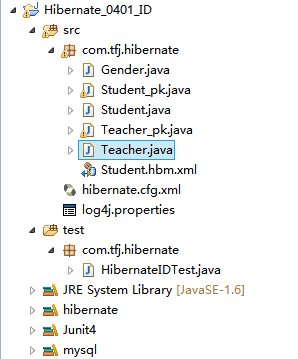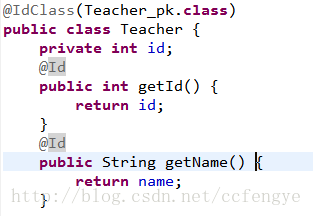Hibernate的ID联合主键——Hibernate学习笔记04
之前写了id的生成策略,但有时候我们的数据库表的主键并不是唯一的一个属性,这就要用到联合主键,配置方法呢同样有两个,xml和annotation。当然我们在设计数据库表的时候尽量不要去这么设计,但是要是遇到了这种情况,要学会配置。
还是先来看项目
对于Student,我们认为age和id作为联合主键,那么新建一个Student_pk.java里面有age 和int 属性还有get方法。
package com.tfj.hibernate;
import java.io.Serializable;
public class Student_pk implements Serializable{
private int id;
private int age;
public int getId() {
return id;
}
public int getAge() {
return age;
}
public void setId(int id) {
this.id = id;
}
public void setAge(int age) {
this.age = age;
}
@Override
public int hashCode() {
return super.hashCode();
}
@Override
public boolean equals(Object obj) {
if(obj instanceof Student_pk){
Student_pk pk= (Student_pk)obj;
if(this.id==pk.getId()&&this.age==pk.getAge()){
return true;
}
}
return false;
}
}
在Student.hbm.xml里有<composite-id>来配置主键<key-property>来指定是哪个属性。
<?xml version="1.0"?>
<!DOCTYPE hibernate-mapping PUBLIC
"-//Hibernate/Hibernate Mapping DTD 3.0//EN"
"http://www.hibernate.org/dtd/hibernate-mapping-3.0.dtd">
<hibernate-mapping>
<class name="com.tfj.hibernate.Student" table="student">
<composite-id name="pk" class="com.tfj.hibernate.Student_pk">
<key-property name="age"></key-property>
<key-property name="id"></key-property>
</composite-id>
<property name="name"></property>
<property name="sex"></property>
<property name="good"></property>
</class>
</hibernate-mapping>
在测试的时候要新建一个主键(Studen_pk.java)
@Test
public void testTeacherSave() {
Teacher t = new Teacher();
Teacher_pk pk = new Teacher_pk();
pk.setId(5);
pk.setName("hello");
t.setPk(pk);
t.setTitle("高级");
t.setYourWifeName("春娇");
t.setBirthDate(new Date());
Session session = sessionFactory.getCurrentSession();
session.beginTransaction();
session.save(t);
session.getTransaction().commit();
}
这里在Student_pk.java里实现了 Serializable接口,实现了序列化。目的是可以方便对象的读取和写入,比如磁盘中。
还要实现equal()和hashcode()方法。
equal()方法当id和age都一样的时候就是相同的。
下面说annotation
annotation要实现这个有3种方法,我看的文档没有给出翻译。(现在我们用Teacher和Teacher_pk来说)是这样如下三种
1)把主键类(Teacher_pk)注册为@ Embeddable,把主键属性(在Teacher里的pk)注册为@Id;
2)把组件的属性注册为@EmbeddeId;
3)把类注解为@IdClass把属于主键的属性注解为@Id;
对于第三种和第二种用的多,关于为什么要有@IdClass,虽然我们在存的时候没有用到这个类,但是在读取的时候还是会用到,所以这个类应该存在。




